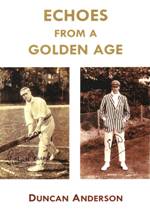Echoes from a Golden Age
Martin Chandler |Published: 2010
Pages: 339
Author: Anderson, Duncan
Publisher: Boundary Books
Rating: 4.5 stars

As cricket books go Echoes from a Golden Age is undoubtedly a luxury item, and a scarce one at that. There are just one hundred signed and numbered copies in existence and, not surprisingly, they can only be obtained direct from the publisher, Boundary Books. All but a handful were sold long before publication, so anyone wanting to buy a copy had better make their move quickly – they will need to bear in mind the hefty price tag, GBP100 or, for the first ten specially bound copies that come with a slip case and a half a dozen facsimile postcards, GBP200.
The book begins with a brief history of the photography business in Brighton, and indeed of photography itself, the purpose of which is to explain the origins of the two firms whose work the book showcases, E Hawkins and Company and Foster and Company. Personally I have no particular interest in photography, nor the development of that industry, but those thirty pages told their story in a manner which held my interest and the reading of which certainly enhanced my appreciation of the rest of the book.
The main section of the book contains well over one hundred full size reproductions of photographs of cricketers that were, in the main, taken between 1904 and 1908. The skill of the photographers and the freshness of the images, even a century on, is what makes these so fascinating. The photographs themselves, and the postcards which they became, do not survive in large numbers and are much sought after by collectors. In the unlikely event that the opportunity arose to acquire a full set of those that are reproduced in Echoes from a Golden Age the cost would be a substantial four figure sum, a useful thought for putting the price of the book in context.
Accompanying each reproduction is a one page pen picture of the player concerned. To capture the essence of a man in around two hundred words is no easy task, but one which Duncan Anderson accomplishes time and again. All the greats are here, men such as Fry, Ranji, Trumper, Hirst and Rhodes, however many more less well known players are featured, some all but forgotten today.
The photographs themselves are all posed, action photography being in its infancy at this time, but the depth and detail of these sepia images is remarkable. A few of the poses, in particular a wonderfully imperious one from Archie MacLaren, make no pretence to being “cricketing” photographs, but in general the batsmen take their stance at the wicket, the bowlers stand in a mock delivery stride and the wicketkeepers guard the stumps.
I suppose it must point to a comparative lack of formal coaching in this era that the batting stances vary so widely. Lionel Palairet, twice capped by England and a Somerset legend was, by all accounts, a most stylish batsman. He demonstrates what I would describe as a classically orthodox stance. In the case of several others, notably the little known Nottinghamshire batsman Charles James, and the exquisitely named Sidney Austyn Paul Kitcat of Gloucestershire, it is not easy to imagine how they might have ever got the ball off the square.
With the wicketkeepers, and there are a number of them, they all crouch behind the stumps, none adopting the squatting position of their modern counterparts. The paucity of protection afforded by their gauntlets, and the same comment can be made of the batsmen’s pads and gloves, is striking.
The appearance of the men themselves is also something that is quite bewildering to those who have grown to love the game through watching modern players who, by and large, deserve to be described as professional athletes. Hampshire’s Harry Baldwin is the most bizarre – granted he was in his forties by the time Thomas Foster photographed him, but he would still make the likes of Mark Cosgrove, Jesse Ryder and Samit Patel feel good about their appearance. At the other extreme I was surprised how, in relative terms, small and frail Lancashire batsman Harry “Shake” Makepeace appeared to be for a man who played for England at both cricket and football, and who must have been in his prime when Foster captured his likeness.
The production standards of Echoes from a Golden Age are clearly, in keeping with the price of the book, a case of no expense having been spared, and that is part of the reason why this is such a beautiful publication to own. That said neither Duncan Anderson’s evocative writing, or the skills of publisher and printer, can alter the fact that the lion’s share of the credit for this book being what it is must go to Foster and his colleagues, who wielded their cameras with such skill in Edwardian Brighton.
For anyone with an interest in the Golden Age, who is still solvent after the ravages of Christmas, I recommend that you contact Mike Down at Boundary Books just as soon as you can.






Leave a comment